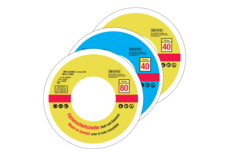Grinding wheels & sandpaper
Sanding paper
Sanding paper is one of the most important home improvement tools and is used for removing surfaces and breaking edges. It consists of artificial grains that can also be used for wet grinding. In addition, not only wood, but also natural and artificial stone, metals or paints can be processed with sandpaper. The use of sanding paper requires clean work. The sanding dust should be knocked out regularly so that the sanding processes achieves the desired result. If too little material is removed during grinding, the sanding paper must be changed. Tip: If a paper with a low grain size is used, it should not be used with too much pressure to avoid damage.
It depends on the grain and the application of the sanding paper. It should be noted that there are letter-number combinations on the back of the sandpaper indicating the hardness of the abrasive grain. The letters A to K stand for soft, L to O for medium and P to Z for hard grains. The number behind the letter indicates the grain of the sandpaper. The higher it is, the finer the grain.
Coarse Grain:
Coarse paper is used for the first section of a wooden surface (grain size between 40 to 120). In addition, unevenness, such as scratches can be removed and straighten the surface. For renovation work, removing wallpaper from walls and ceilings a coarse grain is helpful - because it carries a lot of material and leads to rough surfaces.
Medium grain size:
Medium paper is used after the first rough cut for refinement (grain size between 159 and 180). Wood workpieces can already be painted after this sanding process. In addition, the grain is helpful in removing paint residue or the first beveled metals.
Fine grain:
If a paper with a fine grain size is used (grain size between 220 and 360) the surface is so smooth that e.g. wood can be oiled or waxed directly. For the treatment of metallic surfaces and paints, the grain size may have a value of up to 4000 and more. It can also be used for polishing work.
Grinding wheels
The material to be processed determines the material of the grinding wheel. If material needs to be roughly removed (rough cut), such as for deburring, hard grinding wheels are helpful. Soft grinding wheels are used for fine grinding or polishing work.
Generally, the higher the grit number, the smaller and finer the grain. Attention: With diamond cutting discs, the higher number mark stands for a coarser grain size.
An imbalance may occur if the surface of the grinding wheel is uneven (change in the distribution of bond and abrasive grains). This can be corrected with so-called balancing scales or balancing rollers, so that you get flawless grinding results again.
 Very good (4.64 / 5.00)
Very good (4.64 / 5.00)



















